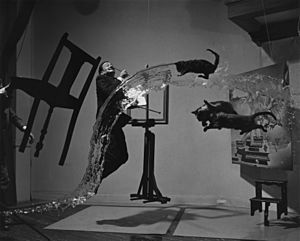Philippe Halsman facts for kids
Philippe Halsman (born May 2, 1906 – died June 25, 1979) was a famous American portrait photographer. He was born in Riga, which was then part of the Russian Empire (and later became Latvia). He passed away in New York City.
Contents
Life and Photography Work
Early Life and Challenges
Philippe Halsman was born in Riga to Jewish parents. His father, Morduch, was a dentist, and his mother, Ita, was a school principal. He studied electrical engineering in Dresden, Germany.
In 1928, when Halsman was 22, he faced a very difficult time. While hiking with his father in Austria, he was wrongly accused of a crime. He spent two years in prison, where he became ill. Many famous people, including Albert Einstein and Sigmund Freud, believed he was innocent and worked to help him get released. He was finally pardoned and set free in 1930.
Moving to France and America
After his release, Halsman left Austria and moved to France. There, he started taking photos for popular fashion magazines like Vogue. He quickly became known as one of France's best portrait photographers. His photos were known for being very clear and focused, often showing people up close.
When Germany invaded France, Halsman had to flee again. With help from his family friend Albert Einstein, he managed to get a visa to the United States. He later took a very famous photo of Einstein in 1947.
Success in the United States
Halsman's first big success in America came when the cosmetics company Elizabeth Arden used his photo of model Constance Ford. The picture showed her against the American flag, promoting a lipstick called "Victory Red."
In 1942, he started working for Life magazine. His first cover for Life was a portrait of a model wearing a special hat. Over his career, he took photos for 101 Life magazine covers!
Working with Salvador Dalí

In 1941, Halsman met the surrealist artist Salvador Dalí. They started working together in the late 1940s, creating some truly unique photos. One of their most famous works is Dalí Atomicus from 1948. This photo shows three cats, a bucket of water, and Dalí himself all floating in the air! It took Halsman 28 tries to get the perfect shot.
Halsman and Dalí also created a book called Dali's Mustache in 1954. It featured 36 different photos of Dalí's famous, unique mustache.
Capturing Famous Faces
In 1947, Halsman took a very famous photo of Albert Einstein. During their session, Einstein talked about his regrets regarding the atomic bomb. This powerful photo was later used on a U.S. postage stamp and on the cover of Time magazine in 1999, when Einstein was named "Person of the Century."
In 1951, a TV company asked Halsman to photograph popular comedians like Milton Berle and Groucho Marx. While taking their pictures, he noticed many of them jumping in the air. This gave him an idea!
Jumpology: The Art of Jumping Photos
Halsman started asking many famous people to jump for his photos. He believed that when people jump, they focus on the act of jumping, and their usual "mask" or expression falls away. This allows their true personality to show. He called this idea "jumpology."
He photographed many celebrities jumping, including Marilyn Monroe and Richard Nixon. In 1959, he published a book called Philippe Halsman's Jump Book, which included 178 photos of famous jumpers and a fun discussion about jumpology.
Halsman's Photography Rules
In his 1961 book, Halsman on the Creation of Photographic Ideas, Halsman shared six rules for photographers to create interesting and unusual pictures:
- The rule of the direct approach: This means taking a straightforward and simple photo to make it strong.
- The rule of the unusual technique: To make an ordinary subject interesting, use different photo techniques like unusual lighting or a unique angle.
- The rule of the added unusual feature: Add something unexpected or strange to the photo to grab the viewer's attention. For example, a photo of a child holding something unusual.
- The rule of the missing feature: Surprise the viewer by leaving something out that they would expect to see.
- The rule of compounded features: Combine several of the other rules to make your photo even more original.
- The rule of the literal or ideographic method: Clearly show a message or idea in your photograph.
More Famous Subjects
Halsman photographed many other well-known people, including Alfred Hitchcock, Judy Garland, Winston Churchill, Pablo Picasso, and Jean Cocteau. Many of these photos appeared on the cover of Life magazine. For example, in one photo of Winston Churchill, Halsman didn't show his face, which made the picture even more powerful.
In 1952, John F. Kennedy sat for Halsman twice. One photo was used on the cover of Kennedy's book Profiles in Courage, and another was used for his campaign to become a senator.
Awards and Recognition
In 1958, Popular Photography magazine named Halsman one of the "World's Ten Greatest Photographers." In 1975, he received the Life Achievement in Photography Award. He was also the first president of the American Society of Magazine Photographers. His work was shown in many large exhibitions around the world.
In 1967, Halsman received the Golden Plate Award from the American Academy of Achievement.
In the 2007 film Jump!, Philippe Halsman was played by actor Ben Silverstone.
See also
 In Spanish: Philippe Halsman para niños
In Spanish: Philippe Halsman para niños
- List of TV Guide covers


